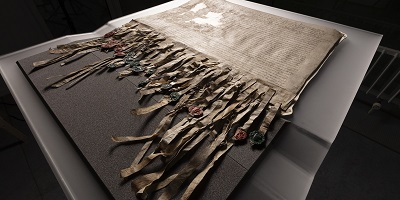Declaration of Arbroath on display
Declaration of Arbroath on display

The Declaration of Arbroath goes on display at the National Museum of Scotland tomorrow (Saturday 3 June) for the first time in 18 years.
As custodians of the Declaration of Arbroath, National Records of Scotland has worked in partnership with National Museums Scotland on the display. The famous document will be on show until July 2023.
It was last displayed 18 years ago at the Scottish Parliament. The iconic and fragile 700-year-old document, which is cared for and preserved for future generations by NRS conservation experts, can only be displayed occasionally in order to ensure its long-term preservation.
The Declaration of Arbroath is a letter dated 6 April 1320, written by the barons and freeholders of Scotland, on behalf of the Kingdom of Scotland, to Pope John XXII asking him to recognise Scotland's independence and acknowledge Robert the Bruce as the country's lawful king.
The Declaration was probably drafted at a meeting of the King and his council at Newbattle, then written up in the scriptorium of Arbroath Abbey. Written in Latin, it was sealed by eight earls and about 40 barons. It was authenticated by seals, as documents at that time were not signed. Only 19 seals now remain.
Dr Alan Borthwick, Head of Medieval and Early Modern Records, National Records of Scotland, said:
“The Declaration of Arbroath is one of the most significant documents we have in our collections. At National Records of Scotland we are hugely proud of the role we play in conserving it to ensure it is still here for future generations to see and study. We hope people from Scotland and beyond will take this rare opportunity to see it for themselves.”
Alice Blackwell, Senior Curator of Medieval Archaeology and History at National Museums Scotland said,
“It is great to be able to display the Declaration of Arbroath at the National Museum of Scotland, the home of our nation’s material history and the country’s most visited attraction. We look forward to welcoming many visitors to enjoy the rare opportunity of seeing this hugely significant document in person.”
Culture Minister Christina McKelvie said:
“The Declaration of Arbroath is of great historic and cultural interest to people living in Scotland as well as the sizeable Scottish diaspora around the world. I hope people from across the country, and further afield, will take this rare opportunity to visit our wonderful national museum to view this iconic document which has played such an important part in the history of our country.”
Background
The Declaration was due to be displayed in April 2020 to coincide with its 700th anniversary, but this was postponed due to the pandemic.
The Declaration was written during the long Wars of Independence with England when, despite the Scots’ success at the Battle of Bannockburn, Robert I had not been recognised as king by either Edward II or by the Pope, and had been excommunicated by the latter. At this time, the Pope desired peace between England and Scotland, so both could help in a crusade to the Holy Land. The Declaration sought to influence him by offering the possibility of support from the Scots for his long-desired crusade if they no longer had to fear English invasion.
After receiving the Declaration, the Pope urged reconciliation between the warring sides and a truce was agreed in 1323. A peace treaty was signed between England and Scotland in March 1328 and the following year the Pope issued a papal bull permitting the anointing and crowning of a King of Scots. The peace was short-lived, however, as the Second War of Independence broke out in 1332 and went on for 25 years.